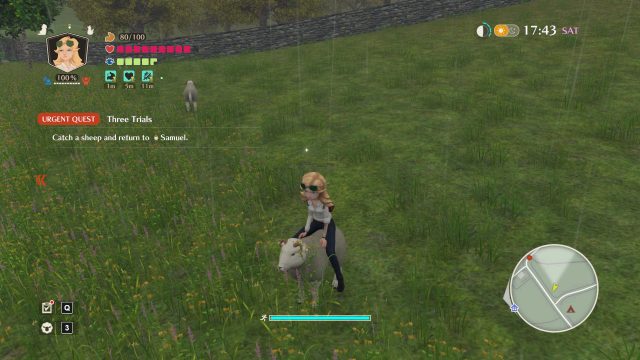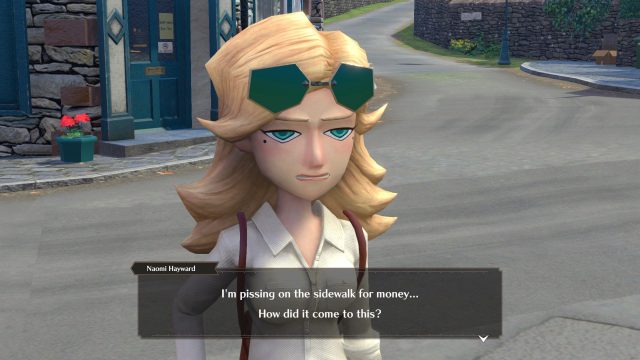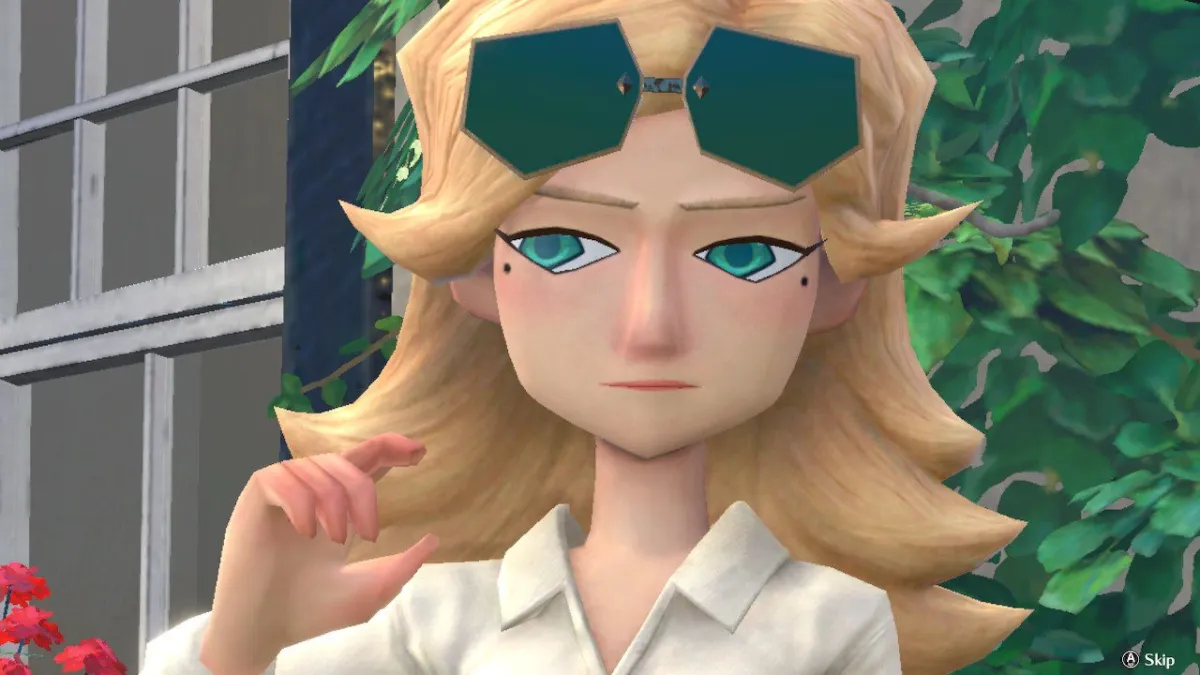Deadly pre-meow-nition
It’s honestly difficult to think about where to start with The Good Life. It is the latest from White Owls and Hidetaka Suehiro, a.k.a. Swery. From its outset, you are Naomi Hayward, a photojournalist who’s accrued inhuman amounts of debt. And so you’ve been sent to Rainy Woods, a quiet English town dubbed the happiest place on Earth, to uncover their secrets using your detective skills and trusty camera.
Then the moon illuminates the night sky, and the townspeople turn into dogs and cats. And soon, so can you. The Good Life is certainly a photography game mixed into a little slice-of-life sim, but it’s also got elements of investigation, resource management, and puzzle solving.
The Good Life does a lot, but I don’t really think it does any of it well enough to carry it through. It’s a world held aloft by its quirkiness and charm, but the way it barely fits together and often grinds its own gears into itself can wear its cheerful veneer thin.
The Good Life (Nintendo Switch, PC [reviewed], PS4, Xbox One)
Developer: White Owls Inc.
Publisher: Playism
Released: Oct. 15, 2021
MSRP: $29.99
Not long after Naomi arrives in town, eager to uncover the secrets of Rainy Woods and learning to transform into both a dog and cat herself, she stumbles upon even more intrigue. A well-liked local is murdered, and Naomi has only a few clues to go on as she ventures out to both discover more secrets and find the killer.
This might sound like an appealing scenario for fans of Swery’s Deadly Premonition, and it definitely has tinges of that, in both the small-town setting and penchant for the supernatural. But The Good Life doesn’t just lean into the uncanny and odd, it leaps for it.
Over the course of about 10 to 12 hours to see the main narrative through, parts of the story can feel like they’re whisking you between ever-increasing fantastical activities. The surprise of finding out just how far these go is one of the highlights, and so I’ll avoid spoiling them; but I will say, there were multiple times where I thought a story had reached its peak absurdity, and it escalated even further.
But between its peaks of bizarre surprise, there is also a lot of just walking around. The Good Life might hit the gas when it calls for it, but on the whole, it’s a game where you are moving from place to place as often as you’re doing things in those places. And movement always costs you.

The Good Life has a constant running clock, on a running calendar complete with moon cycles and important events on certain days of the week. Characters will be in places and, importantly, only be available for some tasks at certain times of the day.
You do have health, but that’s honestly the meter I paid the least amount of attention to. Instead, I was usually watching my stamina, as I ran in short sprints through the English countryside; or hunger, slowly creeping down throughout the day; or my wellness, separate from my health, which could lead to a cold or a headache if left unattended. Medical bills aren’t cheap either. And at some point, I’ll need to sleep too, or risk passing out from exhaustion.
The world is fairly large, with the quiet town of Rainy Woods in the center of a countryside that also contains lakes, quarries, ruins, farms, and even a mountain range. It’s also fairly spread out, and until you get a faster means of travel part-ways into the main quest line, you’re hoofing it (or pawing it, in animal mode).

Generally, I liked how easygoing this still felt. I would fill my quest log with little activities and tick them off as I went about my day. On my way to see one character to advance a main plot point, I could also stop off to eat some food, catch up with the quirky and endearing folks living in Rainy Woods, and take a few snapshots to boost up my social media account. Of course, it all could all fall apart thanks to a little cold or a shortage of cash, and then you’re sent into a spiral trying to scrape together what you need to be healthy again and resume a quiet, easygoing rural life.
The most steady income in The Good Life comes from Flamingo, a social media app where you upload photos you take in the world and get paid for likes, or “Emokes.” The photography works, and I like that there are also options for picking up additional lenses in a wide-angle and telephoto lens. There isn’t much more customization beyond that, and it was really more point-and-click than something with involved post-processing or finicky camera controls, but it fits the vibe.
It’s more that the photography felt underutilized, and much like other aspects of The Good Life, starts to feel like an afterthought. The Good Life introduces a lot of ideas and then moves them aside for other ideas. At the start of the game, it seems like a mystery game where getting to know the locals and snap good shots will be key. Instead, I spent a lot of time riding sheep and tracking smells as a dog.
Most of the photo targets focus on either searching for an object or setting in the world, or in some cases, waiting for a person to do something so you can snap a picture of it. And getting more Emokes in general entails adhering to certain “buzzwords” that refresh twice a week. They encourage paying attention to the environment, but also feel like they could be a bit more involved. There are a lot of side quests that I could only make a fair dent in, so there might be more there as each citizen’s quest line goes deeper, but I soon saw side quests as a means to earn cash rather than something I was eager to engage with.

There were also some weird cases of certain side quests not tracking what I had done unless I had them active, while others did. In general, I didn’t encounter anything else majorly buggy, but the performance of The Good Life on different platforms is something to make note of. I played through the game on PC, but I did spend a few hours with the Switch version, and the difference is really noticeable. It chugs and forgoes some of the graphical features that smooth out The Good Life‘s graphics in the PC version, making it look and play rougher. The Good Life isn’t a visual powerhouse either, but it has a certain charm to its look, and that charm comes across better when it isn’t stuttering.
By story’s end, it felt like The Good Life had lost the threads of its story, as it tried to wrap up a lot of story beats while also bringing things to a close and showing how Naomi, a jaded photojournalist apathetic towards anything not involving money, can start to care about more than just her debt.
And even though I liked some of the quirky characters in Rainy Woods, and enjoyed how over-the-top its story beats went, and found an endearing charm to managing its many meters and side activities to become both a successful detective and titanic influencer, The Good Life feels like it spreads itself too thin to make its breadth feel impactful.
It’s cool I can mine for ore, then turn it into chunks and use those to fund a home renovation, but the individual steps of that feel too similar to taking a special picture for a townsperson or gathering mushrooms for a new dish. Their simplicity makes tasks feel too repetitive after enough time doing them. There are a lot of things to do in The Good Life, but the reward is often just getting to do more of it. And in between doing those tasks, there’s lots and lots of travel, unless you want to spend some cash to fast travel between the animal shrines you unlock around the map.

There are certainly folks this will appeal to, especially if they like the feeling of checking tasks off lists in a virtual world. But even then, there are other games that do this better. Between all of the hobbies and sidequests Naomi can pick up, there’s a lot to do but not quite enough to set it apart. The quirkiness of its world and characters is the one aspect that really makes The Good Life feel its own, and it has to carry a lot on its shoulders. Even exciting aspects, like turning into a dog or cat, feel mundane after a while.
The Good Life does many things, but they never felt like they coalesced together into an experience that could stick with me. I certainly enjoyed parts of it, and some of its stranger moments really do land as big, enjoyable peaks. But there’s a lot of valley in-between, and while I arrived in Rainy Woods eager for a pleasant countryside escape, I didn’t feel like making a return trip after the credits had rolled.
[This review is based on a retail build of the game provided by the publisher.]





Published: Oct 15, 2021 05:00 pm